 Category winner in these countries:
Category winner in these countries:
Realiseren van de uitbreiding van het sportcomplex te Lille
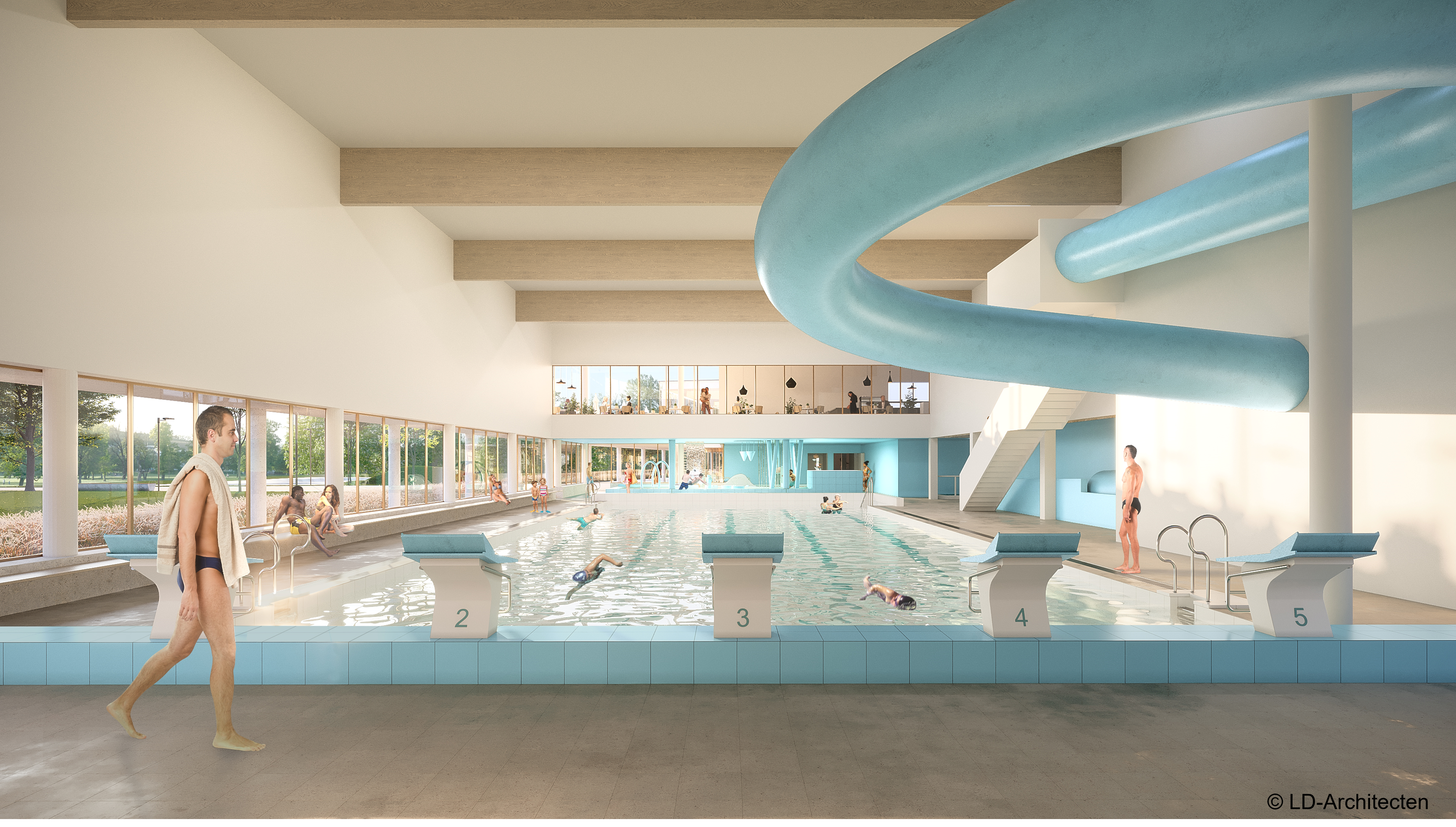
| Category | Sport and Recreation |
|---|---|
| Year | 2022 |
| Country | Benelux |
| Organization | Tractebel |
| Project partners | LD-Architecten, Groep Van Roey, Equans |
| Author | Tractebel |
| Co-authors | LD-Architecten, Groep Van Roey, Equans |
| Client | Groep Sportoase NV |
| Place of construction | Lille |
| Tags |
Het project betreft een uitbreiding van het sportcomplex te Lille, op de site van het sportcentrum Balsakker. Deze uitbreiding omvat onder andere een zwembad, cafetaria en fitness. Het zwembadgedeelte omvat een groot 25m-bad met beweegbare bodem, een peuterbad, glijbaan en wellness, met aansluitend kleedkamers en lockers. De nieuwe cafetaria sluit aan op de cafetaria in het bestaande complex. De structuur van de uitbreiding staat structureel volledig los van de structuur van het bestaande gebouw.
Tractebel stond met dit ontwerp voor een multidisciplinaire opdracht. Een project dat vraagt om een geïntegreerde BIM aanpak. Tekla Structures werd vanaf de start ingezet als modelleer software voor de structuur (zowel beton, staal als hout). De verschillende 3D discipline modellen werden samengebracht in BIM 360 en werd beheerd door Groep Van Roey. Zo werden ook de 3D IFC-modellen van architectuur en diverse technieken (HVAC, elektriciteit, sanitair, riolering en waterbehandeling) in het model ingeladen. Het 3D-IFC model architectuur werd aangeleverd door LD Architecten, de diverse technieken door Tractebel tot LOD200, om daarna te worden omgezet tot een hoger LOD door de uitvoerende aannemers.
Door deze aanpak konden alle raakvlakken tussen de diverse ontwerpdisciplines goed in beeld gebracht worden. Het werd snel duidelijk dat de verschillende technische disciplines een prominente rol zouden gaan spelen. De omvang en complexiteit van het leidingennetwerk in een zwembad zijn aanzienlijk. Daardoor ontstond de noodzaak om al in de ontwerpfase de nodige sparingen te voorzien in de structuur. De techniekontwerpers leverden IFC-modellen aan met dummy elementen die de sparingen definieerden in afmeting en positie. Deze dummy elementen werden geconverteerd naar native Tekla objecten, waardoor het voorzien van de juiste sparing op de juiste plaats vlekkeloos kon verlopen.
Om de verdere coördinatie tussen de modellen van de verschillende partijen te faciliteren werd er gebruik gemaakt van BIMcollab. Dit platform, dat ook beschikbaar is vanuit de native software van de modelleurs, maakte model review mogelijk door aan het model verbonden acties te koppelen aan clashes.
Clash detectie gebeurt in de ontwerpfase waardoor problemen tijdens de uitvoering in theorie vermeden worden. Het 3D model werd bovendien door het ontwerpteam gebruikt als communicatietool en visualisatietool, waardoor ook de stakeholders het ontwerp van nabij konden volgen.
Wat betreft de structurele discipline, werd de volledige bekisting in 3D uitgewerkt. Deliverables als bekistingsplannen en meetstaten konden vervolgens gemakkelijk gegenereerd worden uit het model. Nadat de bekisting op punt stond in Tekla, vond een export plaats naar het rekenprogramma Scia Engineer. Voor de uitwisseling werd gebruik gemaakt van de Scia AutoConverter. Vervolgens werd dit rekenmodel gebruikt voor de structurele berekeningen.
Tot slot kunnen we concluderen dat het coördineren van de modellen van de verschillende disciplines wat meer inspanning en werk vraagt in de ontwerpfase, maar dat dit gecompenseerd wordt in de uitvoeringsfase.
The project concerns an extension to the sports complex in Lille, on the site of the Balsakker sports center. This extension includes a swimming pool, cafeteria and fitness area. The swimming pool area includes a large 25m pool with movable floor, a paddling pool, slide and wellness, with adjoining changing rooms and lockers. The cafeteria connects to the cafeteria in the existing complex. The structure of the extension is structurally completely separate from the structure of the existing building.
With this design, Tractebel faced a multi-disciplinary assignment. A project that requires an integrated BIM approach. Tekla Structures was used from the start to model the structure (concrete, steel and wood). The different 3D discipline models were brought together in BIM 360 and managed by Groep Van Roey. The 3D IFC models of architecture and various techniques (HVAC, electricity, plumbing, sewerage and water treatment) were also loaded into the model. The 3D IFC model of architecture was supplied by LD Architects, the various techniques by Tractebel up to LOD200, and then converted to a higher LOD by the executing contractors.
This approach allowed all interfaces between the various design disciplines to be properly visualized. It quickly became clear that the various engineering disciplines would play a prominent role. The size and complexity of the pipe network in a swimming pool are considerable. This created the need to provide the necessary cutouts in the structure as early as the design phase. The technical designers provided IFC models with dummy elements that defined the dimensions and position of the recesses. These dummy elements were converted into native Tekla objects, which made the provision of the right cutout in the right place a breeze.
BIMcollab was used to facilitate coordination between the models of the different parties. This platform, which is also available in the native software of the modelers, enabled model review by linking actions to clashes.
Clash detection is done in design phase which theoretically avoids problems during execution. Moreover, the 3D model was used by the design team as a communication tool and visualization tool, which also allowed stakeholders to follow the design closely.
Regarding the structural discipline, the entire formwork was worked out in 3D. Deliverables such as formwork plans and measuring sheets could then be easily generated from the model.
After the formwork was finalized in Tekla, an export to the analysis program Scia Engineer took place. For the exchange, the Scia AutoConverter was used. Next, this analysis model was used for the structural calculations.
In conclusion, coordinating the models of the different disciplines requires some more effort and work in the design phase, but is compensated in the execution phase.




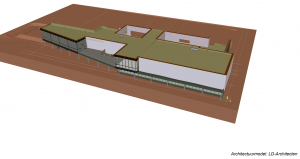
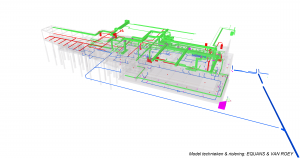
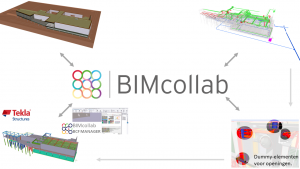
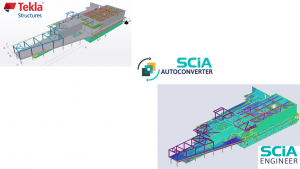

Looks good. Interesting project! Congratulations!